warning FORD C MAX 2011 2.G Repair Manual
[x] Cancel search | Manufacturer: FORD, Model Year: 2011, Model line: C MAX, Model: FORD C MAX 2011 2.GPages: 296, PDF Size: 7.87 MB
Page 129 of 296
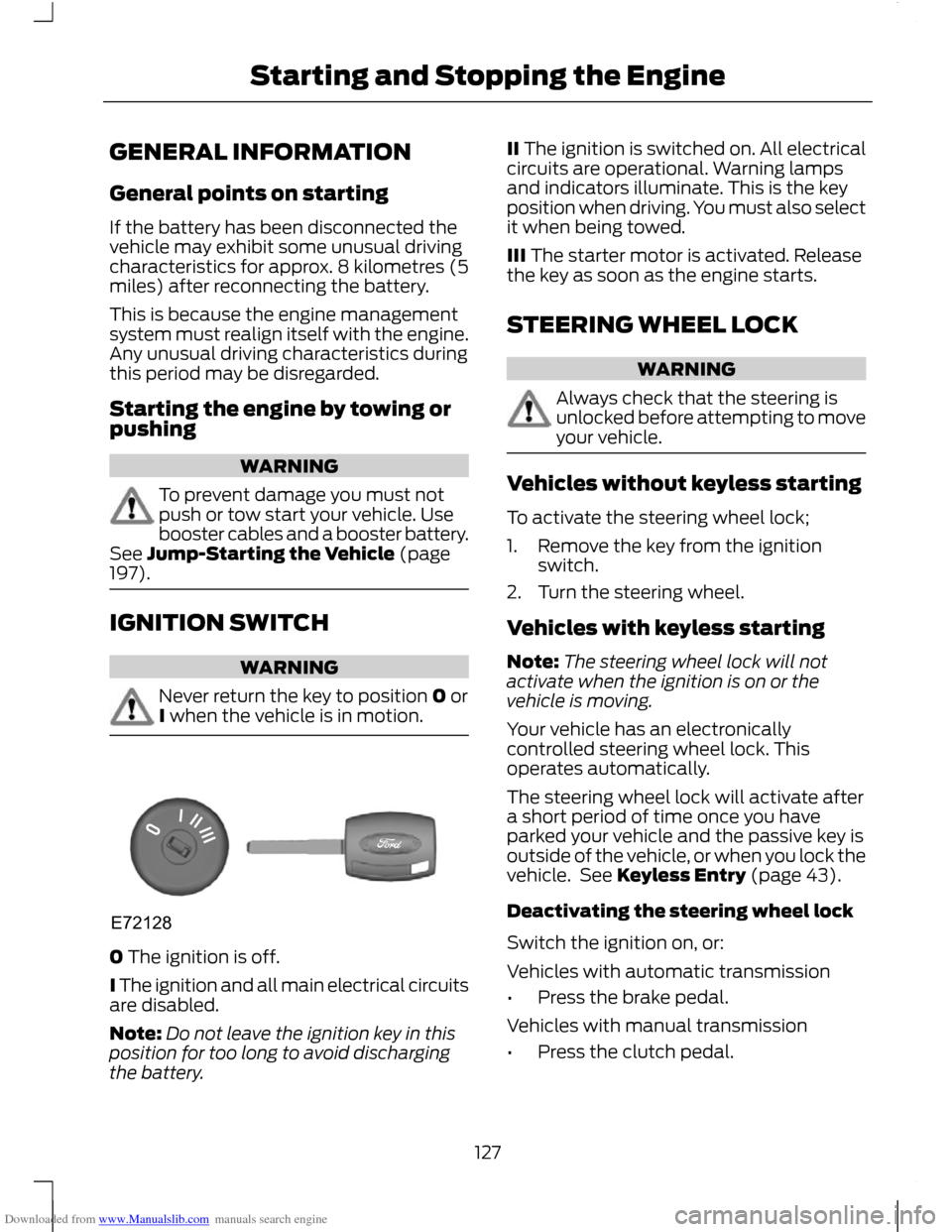
Downloaded from www.Manualslib.com manuals search engine GENERAL INFORMATION
General points on starting
If the battery has been disconnected the
vehicle may exhibit some unusual driving
characteristics for approx. 8 kilometres (5
miles) after reconnecting the battery.
This is because the engine management
system must realign itself with the engine.
Any unusual driving characteristics during
this period may be disregarded.
Starting the engine by towing or
pushing
WARNING
To prevent damage you must not
push or tow start your vehicle. Use
booster cables and a booster battery.
See Jump-Starting the Vehicle (page
197). IGNITION SWITCH
WARNING
Never return the key to position 0 or
I when the vehicle is in motion.
0 The ignition is off.
I The ignition and all main electrical circuits
are disabled.
Note:
Do not leave the ignition key in this
position for too long to avoid discharging
the battery. II The ignition is switched on. All electrical
circuits are operational. Warning lamps
and indicators illuminate. This is the key
position when driving. You must also select
it when being towed.
III The starter motor is activated. Release
the key as soon as the engine starts.
STEERING WHEEL LOCK
WARNING
Always check that the steering is
unlocked before attempting to move
your vehicle.
Vehicles without keyless starting
To activate the steering wheel lock;
1. Remove the key from the ignition
switch.
2. Turn the steering wheel.
Vehicles with keyless starting
Note: The steering wheel lock will not
activate when the ignition is on or the
vehicle is moving.
Your vehicle has an electronically
controlled steering wheel lock. This
operates automatically.
The steering wheel lock will activate after
a short period of time once you have
parked your vehicle and the passive key is
outside of the vehicle, or when you lock the
vehicle. See Keyless Entry (page 43).
Deactivating the steering wheel lock
Switch the ignition on, or:
Vehicles with automatic transmission
• Press the brake pedal.
Vehicles with manual transmission
• Press the clutch pedal.
127
Starting and Stopping the EngineE72128
Page 131 of 296
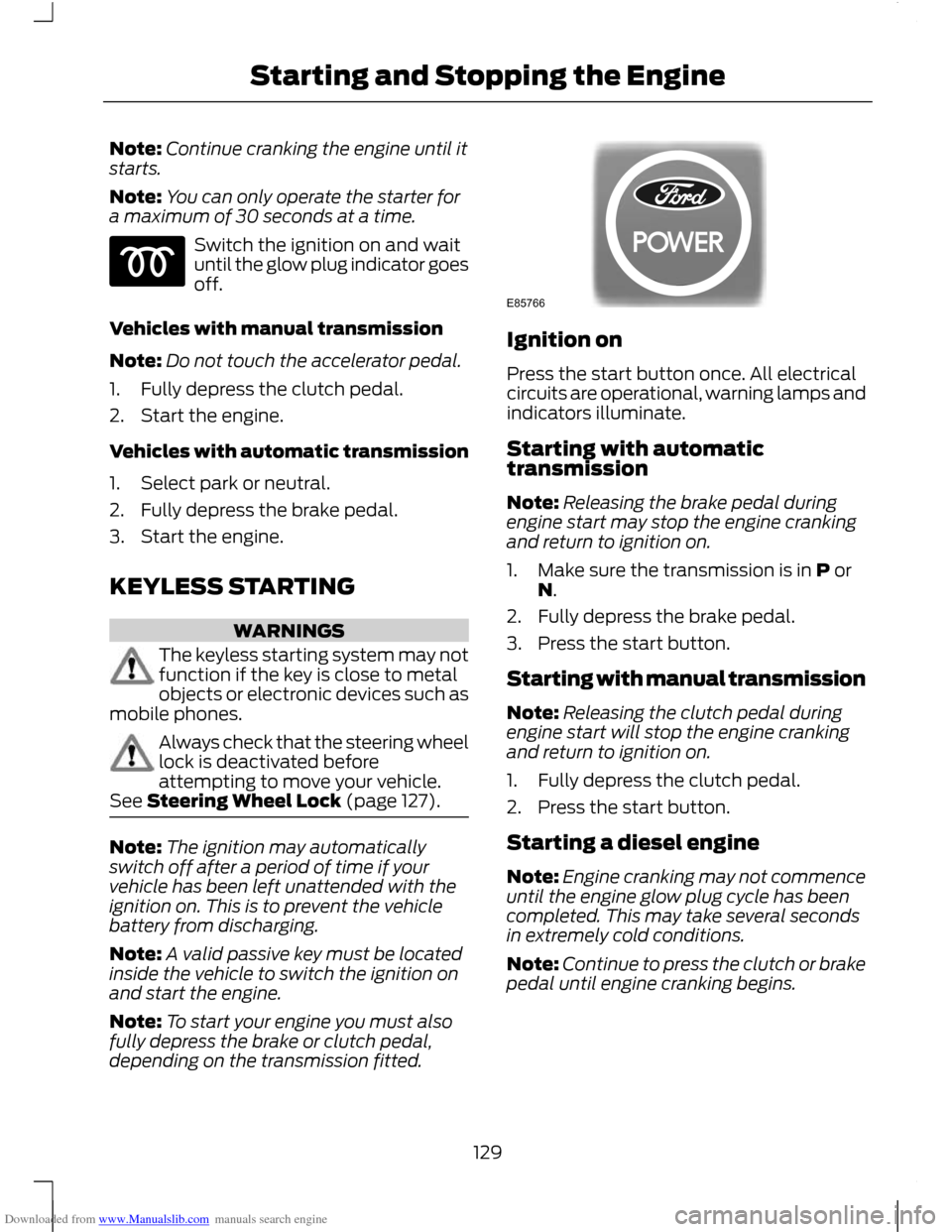
Downloaded from www.Manualslib.com manuals search engine Note:
Continue cranking the engine until it
starts.
Note: You can only operate the starter for
a maximum of 30 seconds at a time. Switch the ignition on and wait
until the glow plug indicator goes
off.
Vehicles with manual transmission
Note: Do not touch the accelerator pedal.
1. Fully depress the clutch pedal.
2. Start the engine.
Vehicles with automatic transmission
1. Select park or neutral.
2. Fully depress the brake pedal.
3. Start the engine.
KEYLESS STARTING WARNINGS
The keyless starting system may not
function if the key is close to metal
objects or electronic devices such as
mobile phones. Always check that the steering wheel
lock is deactivated before
attempting to move your vehicle.
See Steering Wheel Lock (page 127). Note:
The ignition may automatically
switch off after a period of time if your
vehicle has been left unattended with the
ignition on. This is to prevent the vehicle
battery from discharging.
Note: A valid passive key must be located
inside the vehicle to switch the ignition on
and start the engine.
Note: To start your engine you must also
fully depress the brake or clutch pedal,
depending on the transmission fitted. Ignition on
Press the start button once. All electrical
circuits are operational, warning lamps and
indicators illuminate.
Starting with automatic
transmission
Note:
Releasing the brake pedal during
engine start may stop the engine cranking
and return to ignition on.
1. Make sure the transmission is in P or N.
2. Fully depress the brake pedal.
3. Press the start button.
Starting with manual transmission
Note: Releasing the clutch pedal during
engine start will stop the engine cranking
and return to ignition on.
1. Fully depress the clutch pedal.
2. Press the start button.
Starting a diesel engine
Note: Engine cranking may not commence
until the engine glow plug cycle has been
completed. This may take several seconds
in extremely cold conditions.
Note: Continue to press the clutch or brake
pedal until engine cranking begins.
129
Starting and Stopping the Engine E85766
Page 132 of 296
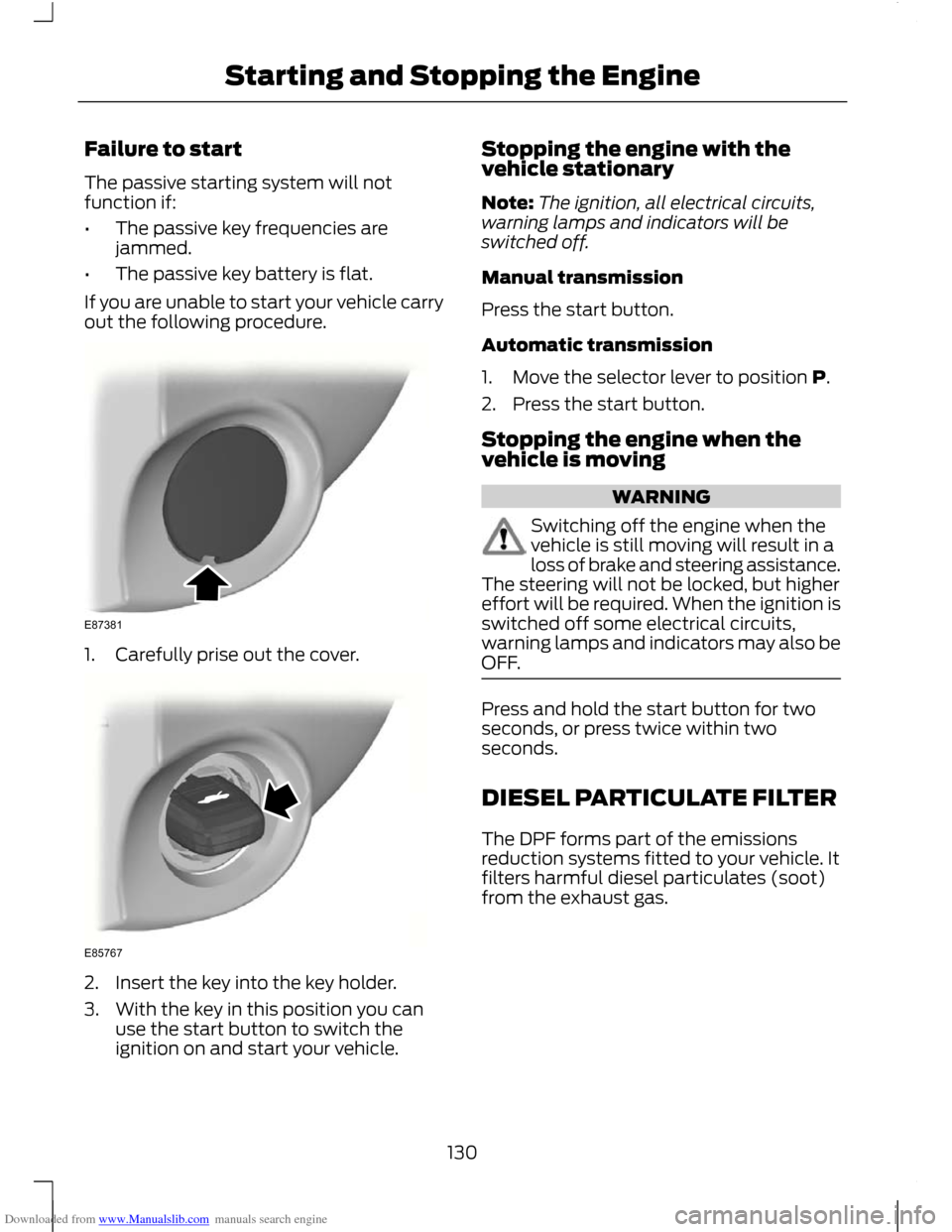
Downloaded from www.Manualslib.com manuals search engine Failure to start
The passive starting system will not
function if:
•
The passive key frequencies are
jammed.
• The passive key battery is flat.
If you are unable to start your vehicle carry
out the following procedure. 1. Carefully prise out the cover.
2. Insert the key into the key holder.
3. With the key in this position you can
use the start button to switch the
ignition on and start your vehicle. Stopping the engine with the
vehicle stationary
Note:
The ignition, all electrical circuits,
warning lamps and indicators will be
switched off.
Manual transmission
Press the start button.
Automatic transmission
1. Move the selector lever to position P.
2. Press the start button.
Stopping the engine when the
vehicle is moving WARNING
Switching off the engine when the
vehicle is still moving will result in a
loss of brake and steering assistance.
The steering will not be locked, but higher
effort will be required. When the ignition is
switched off some electrical circuits,
warning lamps and indicators may also be
OFF. Press and hold the start button for two
seconds, or press twice within two
seconds.
DIESEL PARTICULATE FILTER
The DPF forms part of the emissions
reduction systems fitted to your vehicle. It
filters harmful diesel particulates (soot)
from the exhaust gas.
130
Starting and Stopping the EngineE87381 E85767
Page 133 of 296
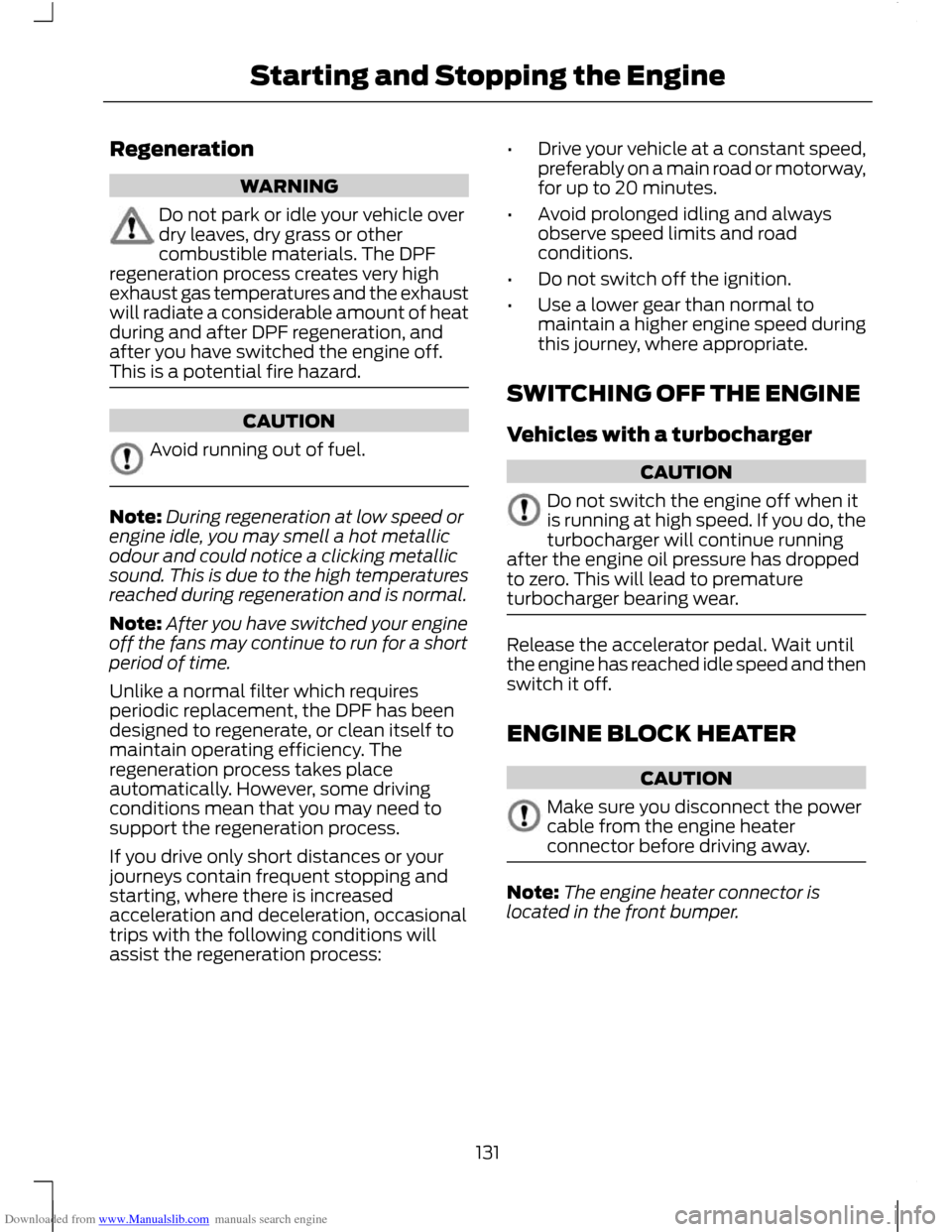
Downloaded from www.Manualslib.com manuals search engine Regeneration
WARNING
Do not park or idle your vehicle over
dry leaves, dry grass or other
combustible materials. The DPF
regeneration process creates very high
exhaust gas temperatures and the exhaust
will radiate a considerable amount of heat
during and after DPF regeneration, and
after you have switched the engine off.
This is a potential fire hazard. CAUTION
Avoid running out of fuel.
Note:
During regeneration at low speed or
engine idle, you may smell a hot metallic
odour and could notice a clicking metallic
sound. This is due to the high temperatures
reached during regeneration and is normal.
Note: After you have switched your engine
off the fans may continue to run for a short
period of time.
Unlike a normal filter which requires
periodic replacement, the DPF has been
designed to regenerate, or clean itself to
maintain operating efficiency. The
regeneration process takes place
automatically. However, some driving
conditions mean that you may need to
support the regeneration process.
If you drive only short distances or your
journeys contain frequent stopping and
starting, where there is increased
acceleration and deceleration, occasional
trips with the following conditions will
assist the regeneration process: •
Drive your vehicle at a constant speed,
preferably on a main road or motorway,
for up to 20 minutes.
• Avoid prolonged idling and always
observe speed limits and road
conditions.
• Do not switch off the ignition.
• Use a lower gear than normal to
maintain a higher engine speed during
this journey, where appropriate.
SWITCHING OFF THE ENGINE
Vehicles with a turbocharger CAUTION
Do not switch the engine off when it
is running at high speed. If you do, the
turbocharger will continue running
after the engine oil pressure has dropped
to zero. This will lead to premature
turbocharger bearing wear. Release the accelerator pedal. Wait until
the engine has reached idle speed and then
switch it off.
ENGINE BLOCK HEATER
CAUTION
Make sure you disconnect the power
cable from the engine heater
connector before driving away.
Note:
The engine heater connector is
located in the front bumper.
131
Starting and Stopping the Engine
Page 135 of 296
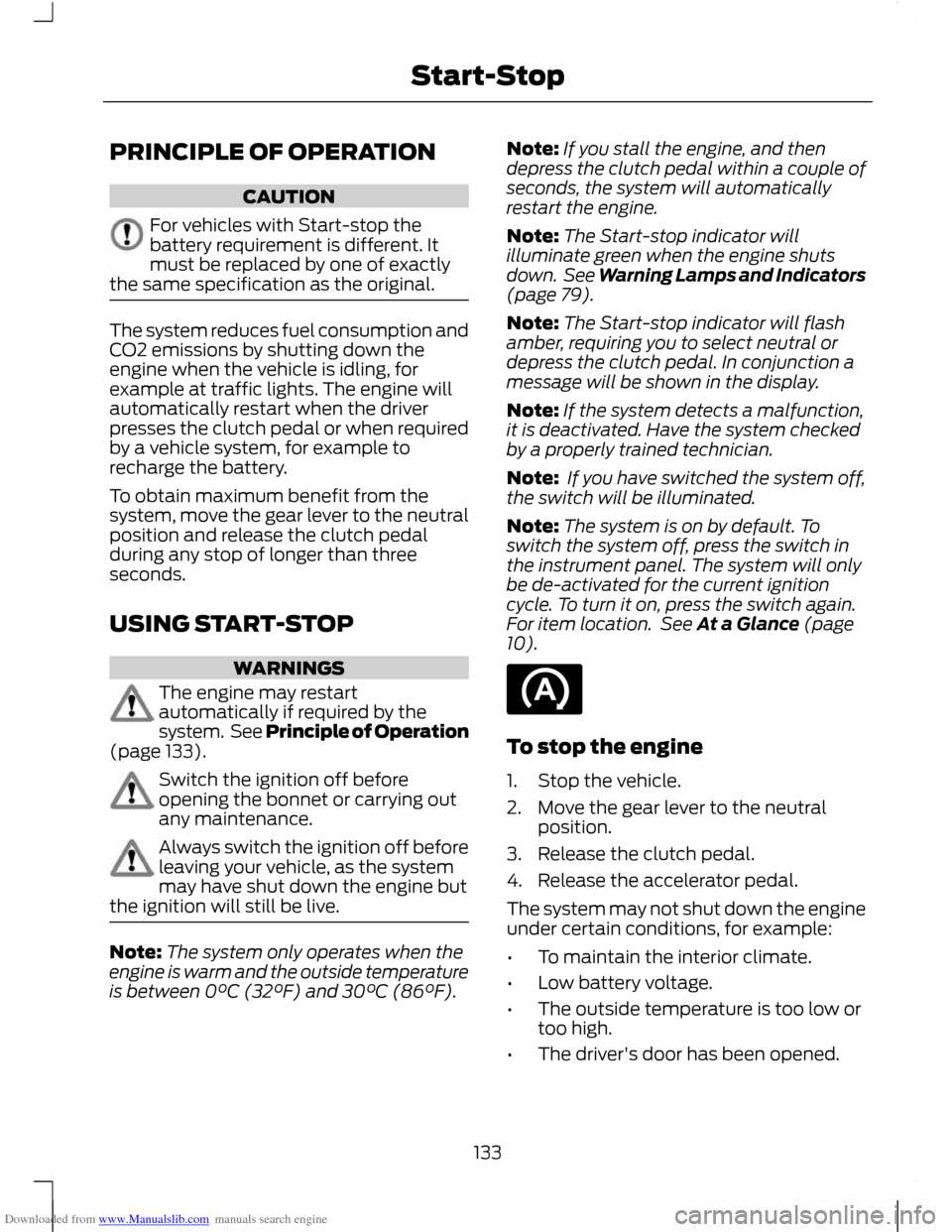
Downloaded from www.Manualslib.com manuals search engine PRINCIPLE OF OPERATION
CAUTION
For vehicles with Start-stop the
battery requirement is different. It
must be replaced by one of exactly
the same specification as the original. The system reduces fuel consumption and
CO2 emissions by shutting down the
engine when the vehicle is idling, for
example at traffic lights. The engine will
automatically restart when the driver
presses the clutch pedal or when required
by a vehicle system, for example to
recharge the battery.
To obtain maximum benefit from the
system, move the gear lever to the neutral
position and release the clutch pedal
during any stop of longer than three
seconds.
USING START-STOP
WARNINGS
The engine may restart
automatically if required by the
system. See Principle of Operation
(page 133). Switch the ignition off before
opening the bonnet or carrying out
any maintenance.
Always switch the ignition off before
leaving your vehicle, as the system
may have shut down the engine but
the ignition will still be live. Note:
The system only operates when the
engine is warm and the outside temperature
is between 0°C (32°F) and 30°C (86°F). Note:
If you stall the engine, and then
depress the clutch pedal within a couple of
seconds, the system will automatically
restart the engine.
Note: The Start-stop indicator will
illuminate green when the engine shuts
down. See Warning Lamps and Indicators
(page 79).
Note: The Start-stop indicator will flash
amber, requiring you to select neutral or
depress the clutch pedal. In conjunction a
message will be shown in the display.
Note: If the system detects a malfunction,
it is deactivated. Have the system checked
by a properly trained technician.
Note: If you have switched the system off,
the switch will be illuminated.
Note: The system is on by default. To
switch the system off, press the switch in
the instrument panel. The system will only
be de-activated for the current ignition
cycle. To turn it on, press the switch again.
For item location. See At a Glance (page
10). To stop the engine
1. Stop the vehicle.
2. Move the gear lever to the neutral
position.
3. Release the clutch pedal.
4. Release the accelerator pedal.
The system may not shut down the engine
under certain conditions, for example:
• To maintain the interior climate.
• Low battery voltage.
• The outside temperature is too low or
too high.
• The driver's door has been opened.
133
Start-Stop
Page 138 of 296
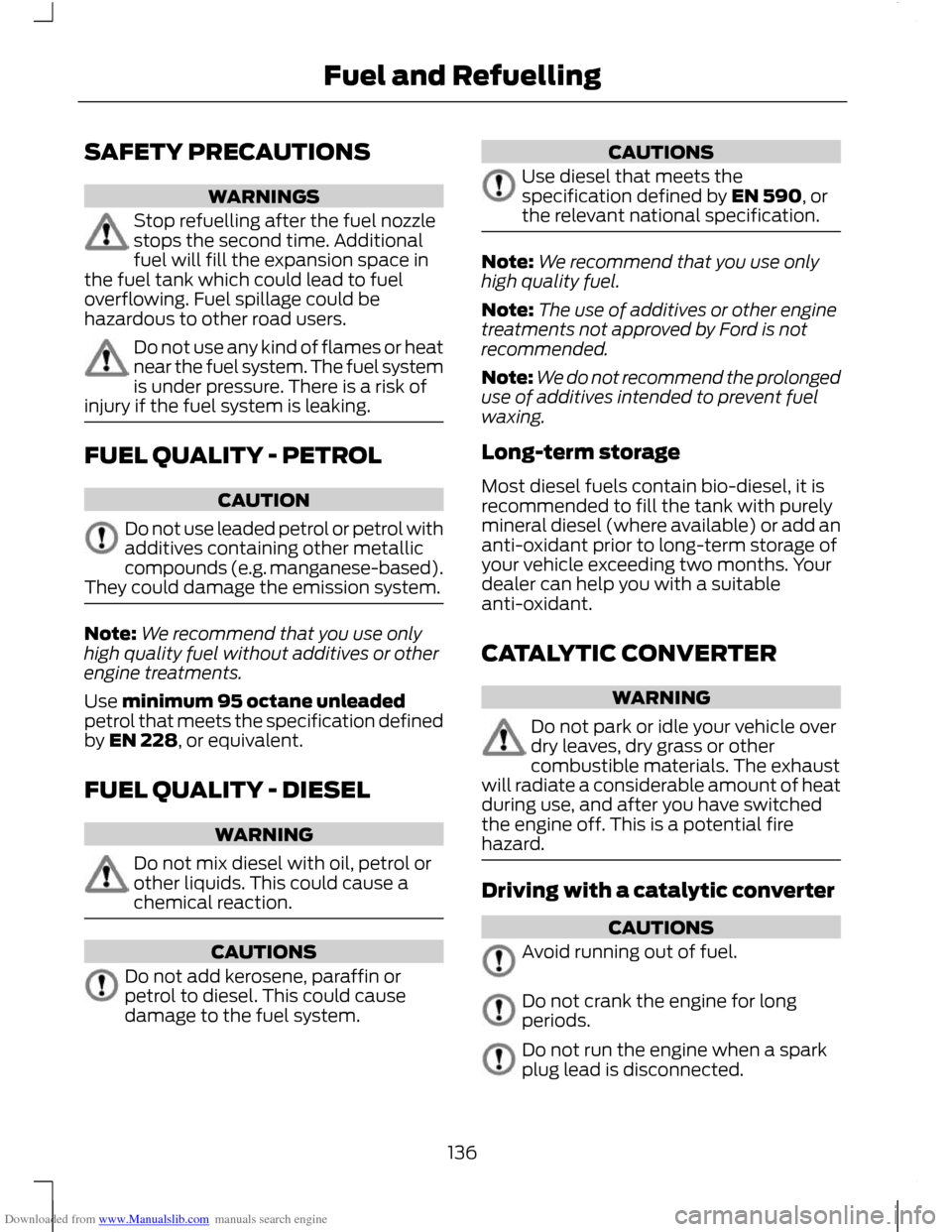
Downloaded from www.Manualslib.com manuals search engine SAFETY PRECAUTIONS
WARNINGS
Stop refuelling after the fuel nozzle
stops the second time. Additional
fuel will fill the expansion space in
the fuel tank which could lead to fuel
overflowing. Fuel spillage could be
hazardous to other road users. Do not use any kind of flames or heat
near the fuel system. The fuel system
is under pressure. There is a risk of
injury if the fuel system is leaking. FUEL QUALITY - PETROL
CAUTION
Do not use leaded petrol or petrol with
additives containing other metallic
compounds (e.g. manganese-based).
They could damage the emission system. Note:
We recommend that you use only
high quality fuel without additives or other
engine treatments.
Use minimum 95 octane unleaded
petrol that meets the specification defined
by EN 228, or equivalent.
FUEL QUALITY - DIESEL WARNING
Do not mix diesel with oil, petrol or
other liquids. This could cause a
chemical reaction.
CAUTIONS
Do not add kerosene, paraffin or
petrol to diesel. This could cause
damage to the fuel system. CAUTIONS
Use diesel that meets the
specification defined by EN 590, or
the relevant national specification.
Note:
We recommend that you use only
high quality fuel.
Note: The use of additives or other engine
treatments not approved by Ford is not
recommended.
Note: We do not recommend the prolonged
use of additives intended to prevent fuel
waxing.
Long-term storage
Most diesel fuels contain bio-diesel, it is
recommended to fill the tank with purely
mineral diesel (where available) or add an
anti-oxidant prior to long-term storage of
your vehicle exceeding two months. Your
dealer can help you with a suitable
anti-oxidant.
CATALYTIC CONVERTER WARNING
Do not park or idle your vehicle over
dry leaves, dry grass or other
combustible materials. The exhaust
will radiate a considerable amount of heat
during use, and after you have switched
the engine off. This is a potential fire
hazard. Driving with a catalytic converter
CAUTIONS
Avoid running out of fuel.
Do not crank the engine for long
periods.
Do not run the engine when a spark
plug lead is disconnected.
136
Fuel and Refuelling
Page 139 of 296
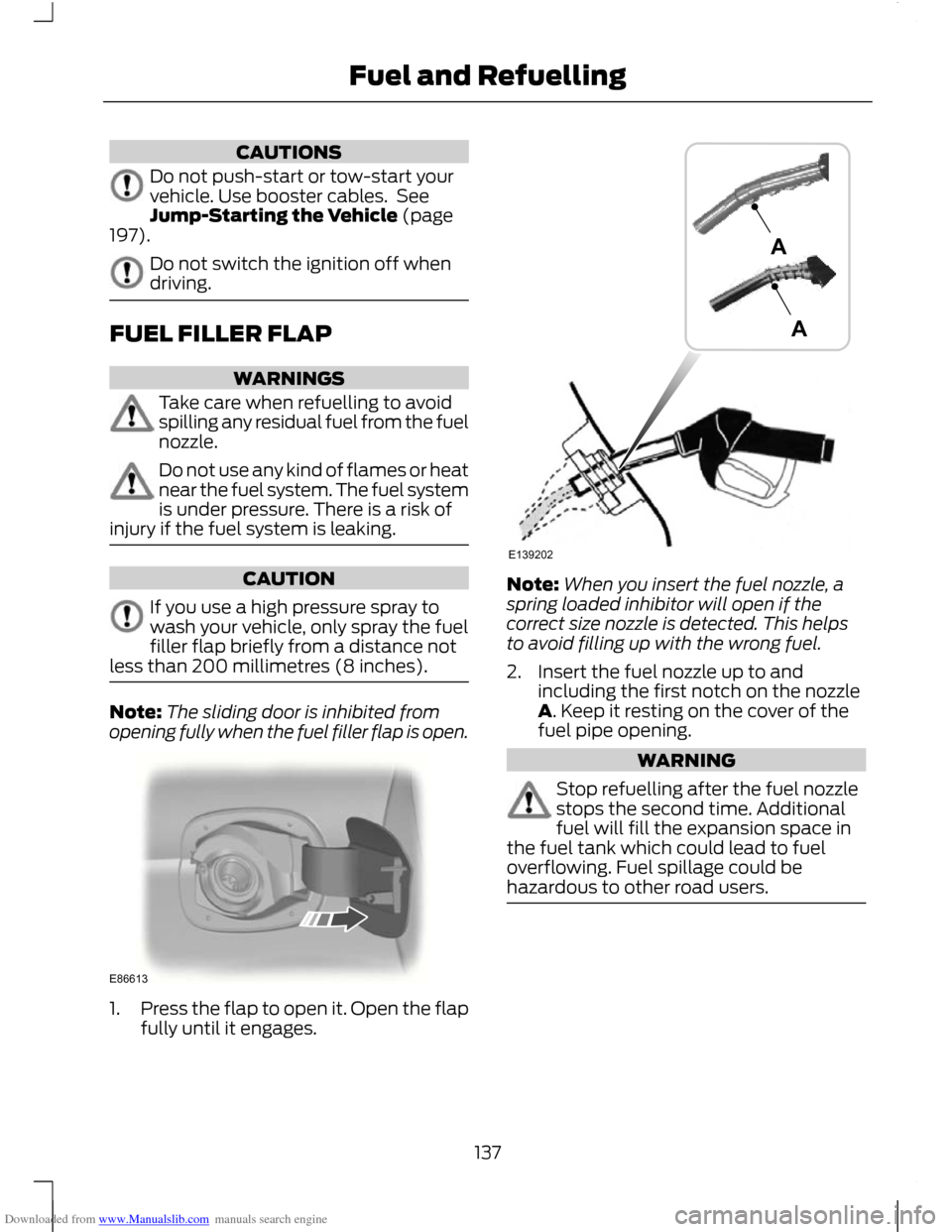
Downloaded from www.Manualslib.com manuals search engine CAUTIONS
Do not push-start or tow-start your
vehicle. Use booster cables. See
Jump-Starting the Vehicle (page
197). Do not switch the ignition off when
driving.
FUEL FILLER FLAP
WARNINGS
Take care when refuelling to avoid
spilling any residual fuel from the fuel
nozzle.
Do not use any kind of flames or heat
near the fuel system. The fuel system
is under pressure. There is a risk of
injury if the fuel system is leaking. CAUTION
If you use a high pressure spray to
wash your vehicle, only spray the fuel
filler flap briefly from a distance not
less than 200 millimetres (8 inches). Note:
The sliding door is inhibited from
opening fully when the fuel filler flap is open. 1.
Press the flap to open it. Open the flap
fully until it engages. Note:
When you insert the fuel nozzle, a
spring loaded inhibitor will open if the
correct size nozzle is detected. This helps
to avoid filling up with the wrong fuel.
2. Insert the fuel nozzle up to and including the first notch on the nozzle
A. Keep it resting on the cover of the
fuel pipe opening. WARNING
Stop refuelling after the fuel nozzle
stops the second time. Additional
fuel will fill the expansion space in
the fuel tank which could lead to fuel
overflowing. Fuel spillage could be
hazardous to other road users. 137
Fuel and RefuellingE86613 E139202AA
Page 140 of 296
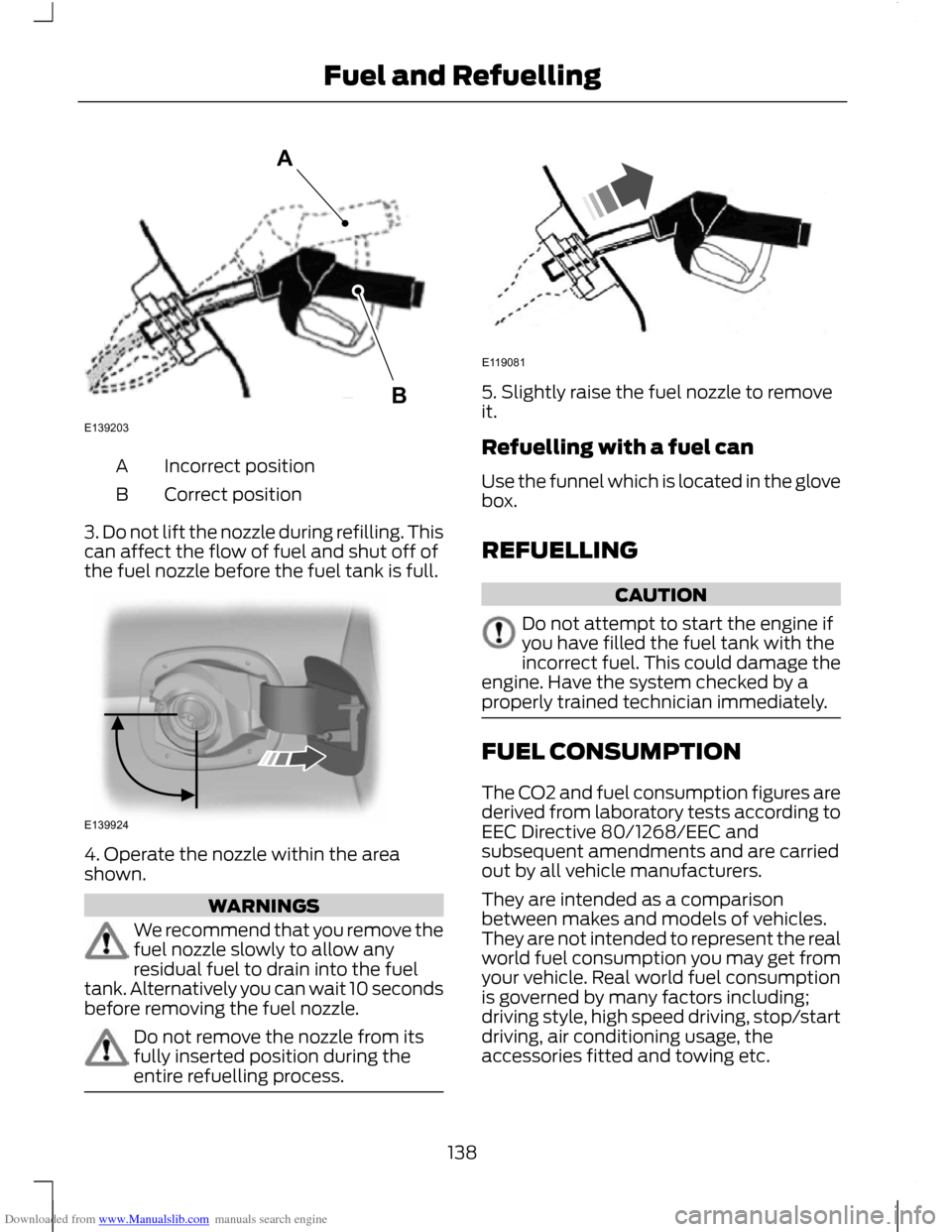
Downloaded from www.Manualslib.com manuals search engine Incorrect position
A
Correct position
B
3. Do not lift the nozzle during refilling. This
can affect the flow of fuel and shut off of
the fuel nozzle before the fuel tank is full. 4. Operate the nozzle within the area
shown.
WARNINGS
We recommend that you remove the
fuel nozzle slowly to allow any
residual fuel to drain into the fuel
tank. Alternatively you can wait 10 seconds
before removing the fuel nozzle. Do not remove the nozzle from its
fully inserted position during the
entire refuelling process. 5. Slightly raise the fuel nozzle to remove
it.
Refuelling with a fuel can
Use the funnel which is located in the glove
box.
REFUELLING
CAUTION
Do not attempt to start the engine if
you have filled the fuel tank with the
incorrect fuel. This could damage the
engine. Have the system checked by a
properly trained technician immediately. FUEL CONSUMPTION
The CO2 and fuel consumption figures are
derived from laboratory tests according to
EEC Directive 80/1268/EEC and
subsequent amendments and are carried
out by all vehicle manufacturers.
They are intended as a comparison
between makes and models of vehicles.
They are not intended to represent the real
world fuel consumption you may get from
your vehicle. Real world fuel consumption
is governed by many factors including;
driving style, high speed driving, stop/start
driving, air conditioning usage, the
accessories fitted and towing etc.
138
Fuel and RefuellingE139203AB E139924 E119081
Page 143 of 296
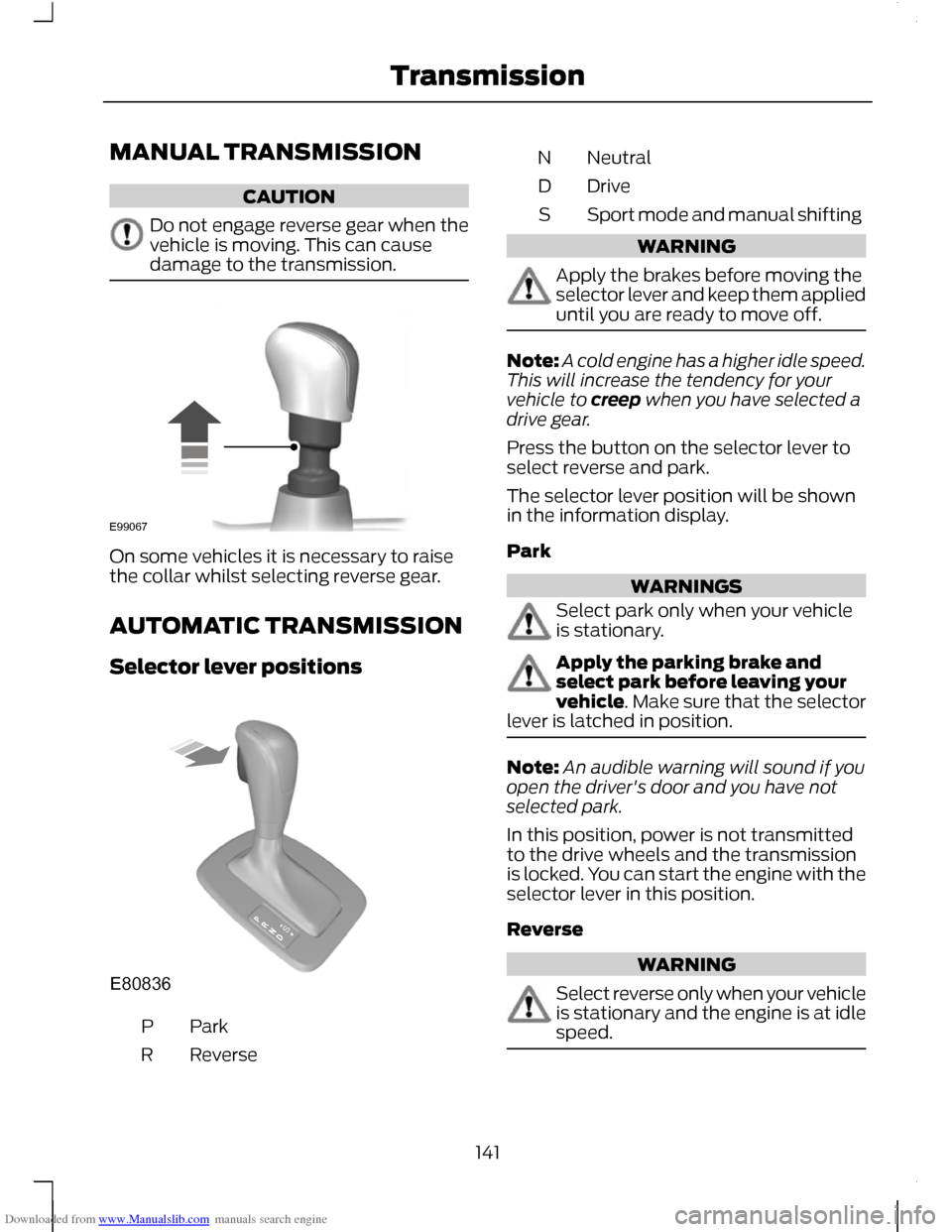
Downloaded from www.Manualslib.com manuals search engine MANUAL TRANSMISSION
CAUTION
Do not engage reverse gear when the
vehicle is moving. This can cause
damage to the transmission.
On some vehicles it is necessary to raise
the collar whilst selecting reverse gear.
AUTOMATIC TRANSMISSION
Selector lever positions
ParkP
Reverse
R Neutral
N
Drive
D
Sport mode and manual shifting
S WARNING
Apply the brakes before moving the
selector lever and keep them applied
until you are ready to move off.
Note:
A cold engine has a higher idle speed.
This will increase the tendency for your
vehicle to creep when you have selected a
drive gear.
Press the button on the selector lever to
select reverse and park.
The selector lever position will be shown
in the information display.
Park WARNINGS
Select park only when your vehicle
is stationary.
Apply the parking brake and
select park before leaving your
vehicle. Make sure that the selector
lever is latched in position. Note:
An audible warning will sound if you
open the driver's door and you have not
selected park.
In this position, power is not transmitted
to the drive wheels and the transmission
is locked. You can start the engine with the
selector lever in this position.
Reverse WARNING
Select reverse only when your vehicle
is stationary and the engine is at idle
speed.
141
TransmissionE99067 E80836S
Page 144 of 296
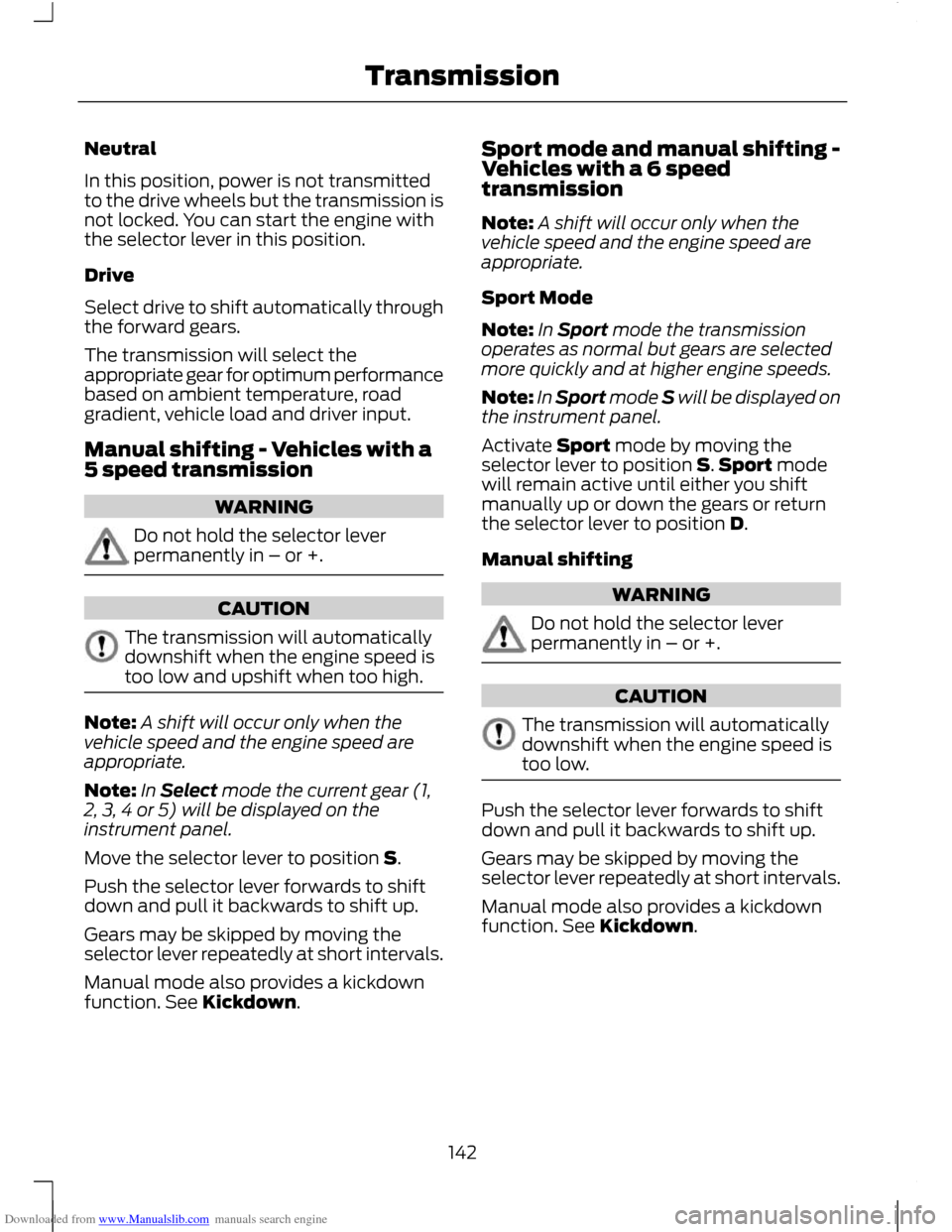
Downloaded from www.Manualslib.com manuals search engine Neutral
In this position, power is not transmitted
to the drive wheels but the transmission is
not locked. You can start the engine with
the selector lever in this position.
Drive
Select drive to shift automatically through
the forward gears.
The transmission will select the
appropriate gear for optimum performance
based on ambient temperature, road
gradient, vehicle load and driver input.
Manual shifting - Vehicles with a
5 speed transmission
WARNING
Do not hold the selector lever
permanently in – or +.
CAUTION
The transmission will automatically
downshift when the engine speed is
too low and upshift when too high.
Note:
A shift will occur only when the
vehicle speed and the engine speed are
appropriate.
Note: In Select mode the current gear (1,
2, 3, 4 or 5) will be displayed on the
instrument panel.
Move the selector lever to position S.
Push the selector lever forwards to shift
down and pull it backwards to shift up.
Gears may be skipped by moving the
selector lever repeatedly at short intervals.
Manual mode also provides a kickdown
function. See Kickdown. Sport mode and manual shifting -
Vehicles with a 6 speed
transmission
Note:
A shift will occur only when the
vehicle speed and the engine speed are
appropriate.
Sport Mode
Note: In Sport mode the transmission
operates as normal but gears are selected
more quickly and at higher engine speeds.
Note: In Sport mode S will be displayed on
the instrument panel.
Activate Sport mode by moving the
selector lever to position S. Sport mode
will remain active until either you shift
manually up or down the gears or return
the selector lever to position D.
Manual shifting WARNING
Do not hold the selector lever
permanently in – or +.
CAUTION
The transmission will automatically
downshift when the engine speed is
too low.
Push the selector lever forwards to shift
down and pull it backwards to shift up.
Gears may be skipped by moving the
selector lever repeatedly at short intervals.
Manual mode also provides a kickdown
function. See Kickdown.
142
Transmission